详解JavaScript的原型与原型链
目录
- 详解原型与原型链
- 构造函数
- 原型对象
- 访问原型
- 设置原型
- 检测原型
- prototype、__proto__、constructor之间的关系
- 原型链
- 原型链的作用
- 普通对象与函数对象
- 经典原型链图
- 总结
详解原型与原型链
其实,刚开始学JavaScript时,就有学过原型与原型链的相关知识了,只是当时还没有养成写笔记的习惯,导致现在已经忘的七七八八了。
这边文章真是花了很多心思,写了两天,看了很多篇篇博文,其中有小参考的,有解决一点疑惑的,但是最后只标注了一篇帮助最大的。
构造函数
实例的构造函数属性(constructor)指向其构造函数
function Person(name) {
this.name = name
}
const person = new Person('clz')
console.log(person.constructor === Person) // true
实例的构造函数并不是自身属性,而是从原型对象上继承的属性
function Person(name) {
this.name = name
}
const person = new Person('clz')
console.log(person.constructor === Person) // true
console.log(Person.prototype.constructor === Person) // true
console.log(person.hasOwnProperty('constructor')) // false:constructor属性并不是实例自身的属性,而是继承来的
原型对象
__proto__(隐式原型):每个对象(除了null)都具有的属性,该属性指向该对象的原型prototype(显式原型):只有函数对象才有的属性,该属性指向函数的原型对象
来看来看
const arr = [1, 2, 3]
const obj = {
name: 'clz'
}
function add(a, b) {
return a + b
}
console.log(arr)
console.log(obj)
console.log(add)
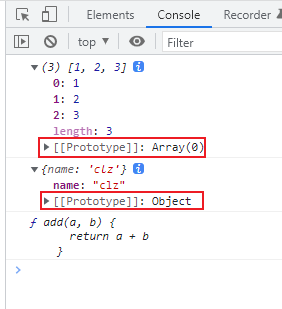
红框框中的[[prototype]]和__proto__意义相同,都是指对象的内部属性
而所有函数都拥有prototype属性,所以可以通过f.prototype得到,那么自然也不需要通过[[prototype]]显示出来(毕竟prototype是显式原型,而__proto__是隐式原型,好吧,这是我猜的)
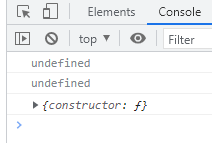
箭头函数没有prototype属性
访问原型
通过实例对象访问原型对象有 3 种方法
obj.__proto__obj.constructor.prototypeObject.getPrototypeOf(obj)
function Person(name) {
this.name = name
}
const person = new Person('clz')
const proto1 = person.__proto__
const proto2 = person.constructor.prototype
const proto3 = Object.getPrototypeOf(person)
const proto = Person.prototype // 原型
console.log(proto1 === proto) // true: 第一种方法
console.log(proto2 === proto) // true: 第二种方法
console.log(proto3 === proto) // true: 第三种方法
比较安全的做法是Object.getPrototypeOf(obj)
以下部分会涉及一丢丢原型链的知识(如果没看懂,可以看下原型链再来看)
__proto__属性是私有属性,存在浏览器兼容性问题,缺乏非浏览器环境的支持- 如果obj的
constructor属性被覆盖,那么obj.constructor.prototype将会失效。(因为obj自身是没有constructor属性的,是通过原型链去它的原型上获取constructor属性,所以覆盖该属性时,将不会再去原型链上查找)
function Person(name) {
this.name = name
}
function Temp(name) {
this.name = name
}
const person = new Person('clz')
person.constructor = Temp
const proto = Person.prototype // 原型
console.log(person.__proto__ === proto) // true: 第一种方法
console.log(person.constructor.prototype === proto) // false: 第二种方法
console.log(Object.getPrototypeOf(person) === proto) // true: 第三种方法
设置原型
设置原型对象有 3 种方法
obj.__proto__=prototypeObjObject.setPrototypeOf(obj, prototypeObj)Object.create(prototypeObj)
const proto = { // 原型对象
name: 'prototype'
}
// 第一种方法
const obj1 = {}
obj1.__proto__ = proto // 设置原型
console.log(obj1.name) // prototype
console.log(obj1.__proto__ === proto) // true
// 第二种方法
const obj2 = {}
Object.setPrototypeOf(obj2, proto) // 设置原型
console.log(obj2.name) // prototype
console.log(obj2.__proto__ === proto) // true
// 第三种方法
const obj3 = Object.create(proto) // 创建对象并设置原型
console.log(obj3.name) // prototype
console.log(obj3.__proto__ === proto) // true
检测原型
使用obj1.isPrototypeOf(obj2)方法判断obj1是否为·obj2的原型
const proto = { // 原型对象
name: 'prototype'
}
const proto1 = {
name: 'prototype'
}
const obj = {}
obj.__proto__ = proto // 设置原型
console.log(proto.isPrototypeOf(obj)) // true
console.log(Object.prototype.isPrototypeOf(obj)) // true
console.log(proto1.isPrototypeOf(obj)) // false
prototype、__proto__、constructor之间的关系
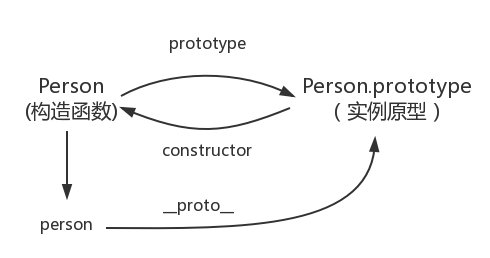
function Person(name) {
this.name = name
}
const person = new Person('clz')
console.log(person.__proto__ === Person.prototype) // true:因为创建person对象的构造函数是Person,所以person对象的隐式原型(__proto__)指向Person函数的原型(prototype)
console.log(Person.prototype.constructor === Person) // true
同一个构造函数创建的多个实例的原型是同一个
function Person(name) {
this.name = name
}
const person1 = new Person('clz')
const person2 = new Person('clz')
console.log(person1 === person2) // false: 不是同一个对象
console.log(person1.__proto__ === person2.__proto__) // true:同一个构造函数创建的实例对象的原型是同一个
原型链
由上面的知识可以知道,实例对象具有属性__proto__,会指向原型对象。而原型对象也是对象,所以也会有属性__proto__,也会继续指向它的原型对象。
实例对象在查找属性时,如果查找不到,就会沿着__proto__去它的原型上查找,还找不到,则继续去原型的原型上查找,直到找到或到最顶层为止。这就是原型链的概念。
对象本身的方法(第一层:把方法当成属性)
function Person(name) {
this.name = name
this.listenMusic = function () {
console.log('听音乐')
}
}
const person = new Person('clz')
console.log(person)
console.log('实例对象本身是否有listenMusic方法', person.hasOwnProperty('listenMusic'))
person.listenMusic()
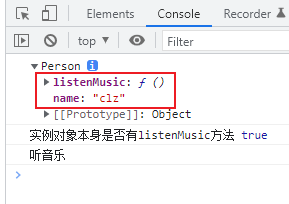
对象的原型上添加方法(第二层)
function Person(name) {
this.name = name
}
Person.prototype.listenMusic = function () {
console.log('听音乐')
}
const person = new Person('clz')
console.log(person)
console.log('实例对象本身是否有listenMusic方法', person.hasOwnProperty('listenMusic'))
person.listenMusic()
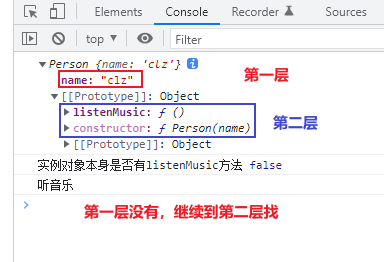
原型的原型上的方法(第三层)
function Person(name) {
this.name = name
}
Person.prototype.__proto__.listenMusic = function () {
console.log('听音乐')
}
const person = new Person('clz')
console.log(person)
person.listenMusic()
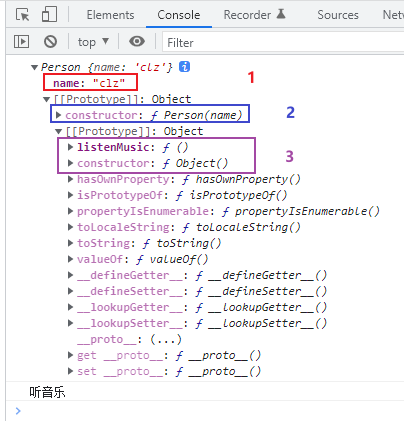
但是呢,没法玩第四层,因为已经到顶了(Object.prototype没有原型(原型为null))
function Person(name) {
this.name = name
}
Person.prototype.__proto__.__proto__.listenMusic = function () {
console.log('听音乐')
}
const person = new Person('clz')
console.log(person)
person.listenMusic()

person -> Person.prototype -> Object.prototype -> null
那么,这里就来看看第三层是不是真的是Object.prototype
function Person(name) {
this.name = name
}
Person.prototype.__proto__.listenMusic = function () {
console.log('听音乐')
}
const person = new Person('clz')
console.log(person)
console.log(Person.prototype.__proto__ === person.__proto__.__proto__)
console.log(person.__proto__.__proto__ === Object.prototype) // 这里就是判断处
person.listenMusic()
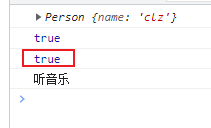
发现,确实如此。
下面这张图就是原型链的简单图(找不到是在哪里截的图了,侵删)
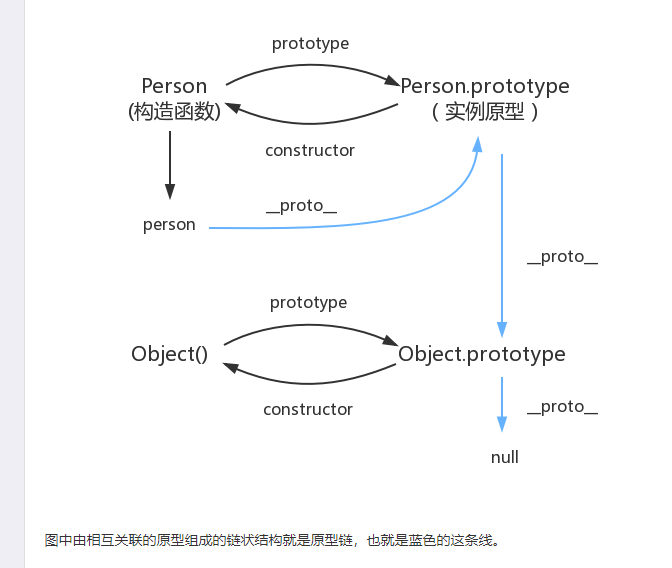
原型链的作用
为对象设置默认值
利用原型为对象设置默认值。当原型属性与私有属性同名时,删除私有属性之后,可以访问原型属性,即可以把原型属性值作为初始化默认值。
function Person(name) {
this.name = name
}
Person.prototype.name = '赤蓝紫'
const person = new Person('clz')
console.log(person.name) // clz
delete person.name
console.log(person.name) // 赤蓝紫
继承
继承内容部分之后单独写。
扩展原型方法
Array.prototype.test = function () {
console.log('扩展原型方法: 有风险')
}
const arr = [1, 2, 3]
arr.test() // 扩展原型方法: 有风险
typeof
typeof是判断类型时大多数人的选择(当然也包括我啦),但是,判断非基本数据类型(function除外)时,只能得到Object。(null也是,但是null这个属于是历史遗留bug了)。
js 在底层存储变量的时候,会在变量的机器码的低位1-3位存储其类型信息
- 000:对象
- 010:浮点数
- 100:字符串
- 110:布尔
- 1:整数
null:所有机器码均为0
undefined:用 −2^30 整数来表示
symbol和bigint是后来新增的数据类型
const num = 123 const str = 'hello' const bool = true const n = null const u = undefined const sym = Symbol(1) const big = BigInt(123) const fun = () => console.log(1) console.log(typeof num) // number console.log(typeof str) // string console.log(typeof bool) // boolean console.log(typeof n) // object console.log(typeof u) // undefined console.log(typeof sym) // symbol console.log(typeof big) //bigint console.log(typeof fun) //function
function除外的非基本数据类型
let arr = []
let obj = {
name: 'clz'
}
let set = new Set([1, 2, 4])
console.log(typeof arr)
console.log(typeof obj)
console.log(typeof set)
清一色object
通过Object.prototype.toString.call(obj)来识别对象类型。会返回"[object Type]"来告诉你所指对象的类型
let arr = []
let obj = {
name: 'clz'
}
let set = new Set([1, 2, 4])
console.log(Object.prototype.toString.call(arr)) // [object Array]
console.log(Object.prototype.toString.call(obj)) // [object Object]
console.log(Object.prototype.toString.call(set)) // [object Set]
instanceof
instanceof只要右边变量的 prototype 在左边变量的原型链上,就会返回true
function Person(name) {
this.name = name
}
function Test(name) {
this.name = name
}
const person = new Person('clz')
console.log(person instanceof Person) // true
console.log(person instanceof Object) // true
console.log(person instanceof Test) // false
普通对象与函数对象
- 所有的函数都是通过new Function()来创建的,即是函数对象
- 其他的都是普通对象
function fn1() { }
const fn2 = function () { }
const fn3 = () => { }
const fn4 = new Function()
console.log(typeof fn1) //function
console.log(typeof fn2) //function
console.log(typeof fn3) //function
console.log(typeof fn4) //function
const obj1 = {}
const obj2 = new Object()
const obj3 = new fn1()
console.log(typeof obj1); //object
console.log(typeof obj2); //object
console.log(typeof obj3); //object
上面的例子中,fn1、fn2、fn3、fn4是函数对象,obj1、obj2、obj3是普通对象
- Object是构造函数,即也是函数,所以
Object也是函数对象,相当于Function的实例,即Object.__proto__ === Function.prototype Object.prototype是Object构造函数的原型,处于原型链的顶端,Object.prototype.__proto__已经没有可以指向的上层原型,因此其值为null
console.log(typeof Object) // function console.log(Object.__proto__ === Function.prototype) // true console.log(Object.prototype.__proto__) // null
Function.prototype是Function的原型,是所有函数对象的原型Function.prototype是一个普通对象,所以Function.prototype.__proto__ === Object.prototypeFunction函数不通过任何东西创建,JS引擎启动时,添加到内存中,所以**Function.__proto__ === Function.prototype**
console.log(typeof Function) // function console.log(Function.prototype.__proto__ === Object.prototype) // true console.log(Function.__proto__ === Function.prototype) // true
经典原型链图
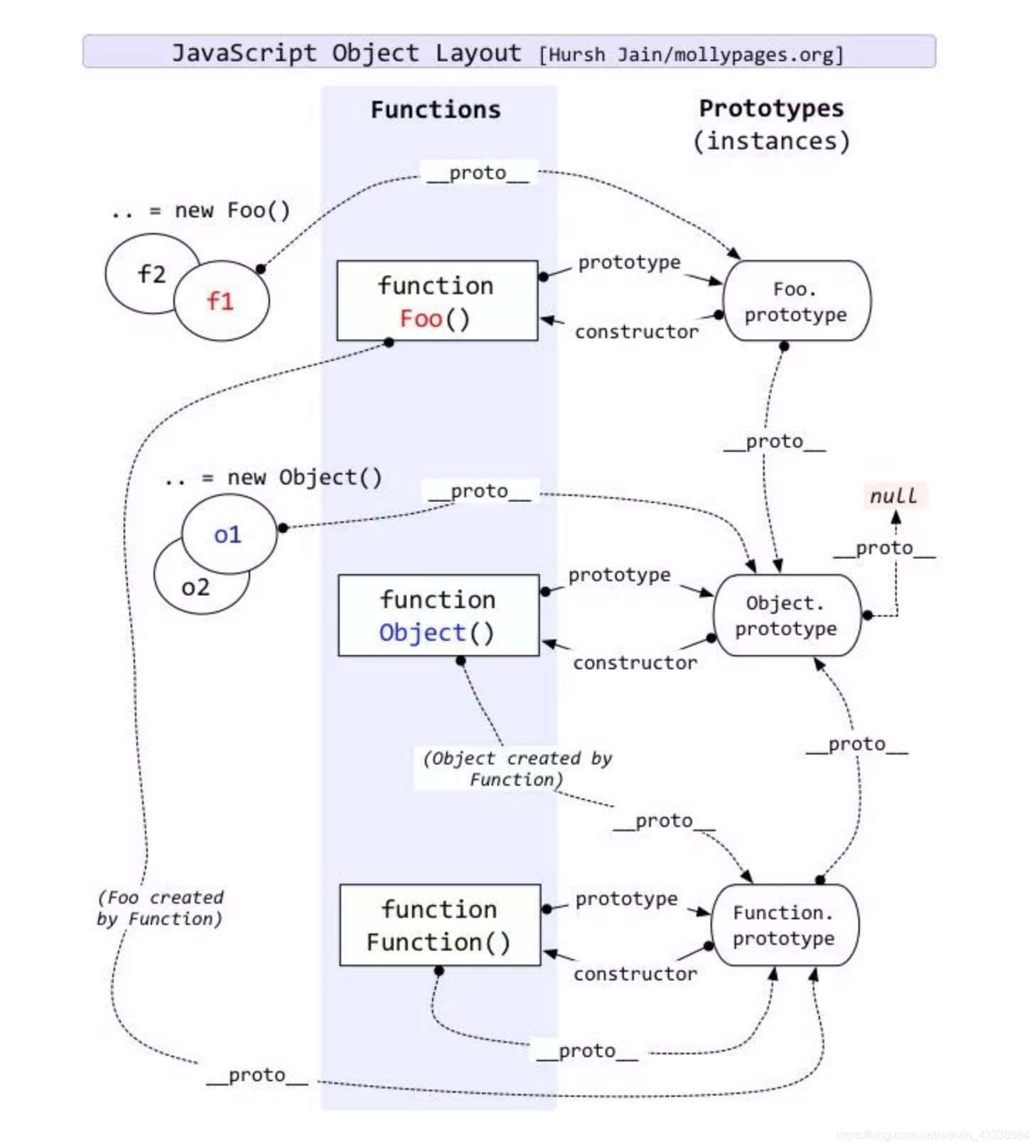
总结
本篇文章就到这里了,希望能够给你带来帮助,也希望您能够多多关注我们的更多内容!

